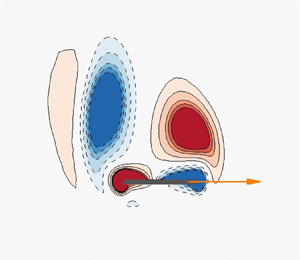Article contents
Fluid–solid Floquet stability analysis of self-propelled heaving foils
Published online by Cambridge University Press: 13 January 2021
Abstract

We investigate the role of linear mechanisms in the emergence of nonlinear horizontal self-propelled states of a heaving foil in a quiescent fluid. Two states are analysed: a periodic state of unidirectional motion and a quasi-periodic state of slow back and forth motion around a mean horizontal position. The states emergence is explained through a fluid–solid Floquet stability analysis of the non-propulsive symmetric base solution. Unlike a purely hydrodynamic analysis, our analysis accurately determines the locomotion states onset. An unstable synchronous mode is found when the unidirectional propulsive solution is observed. The obtained mode has a propulsive character, featuring a mean horizontal velocity and an asymmetric flow that generates a horizontal force accelerating the foil. An unstable asynchronous mode, also featuring flow asymmetry and a non-zero velocity, is found when the back and forth state is observed. Its associated complex multiplier introduces a slow modulation of the flapping period, agreeing with the quasi-periodic nature of the back and forth regime. The temporal evolution of this perturbation shows how the horizontal force exerted by the flow is alternatively propulsive or resistive over a slow period. For both modes, an analysis of the velocity and force perturbation time-averaged over the flapping period is used to establish physical instability criteria. The behaviour for a large solid-to-fluid density ratio of the modes is thus analysed. The asynchronous fluid–solid mode converges towards the purely hydrodynamic one, whereas the synchronous mode becomes marginally unstable in our analysis not converging to the purely hydrodynamic analysis where it is never destabilised.
JFM classification
Information
- Type
- JFM Papers
- Information
- Copyright
- © The Author(s), 2021. Published by Cambridge University Press
References
REFERENCES
- 6
- Cited by


